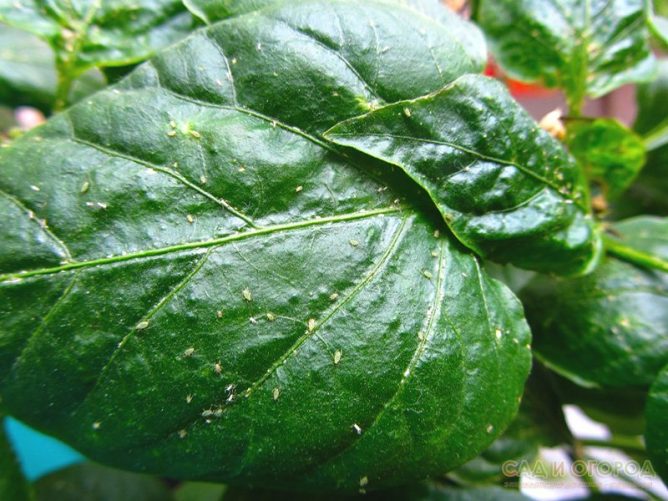 Aphid, despite its microscopic size, is a very dangerous pest for many garden crops, including pepper. Insects can appear not only on plants on the site (on ridges, in greenhouses), but also on seedlings grown at home.
Aphid, despite its microscopic size, is a very dangerous pest for many garden crops, including pepper. Insects can appear not only on plants on the site (on ridges, in greenhouses), but also on seedlings grown at home.
Therefore, it is very important to know all the methods of combating aphids, and also do not forget about prevention.
Content
Signs of aphids on pepper
In nature, there are more than three thousand species of various aphids, while peppers are usually affected by small black aphids (dangerous for seedlings) and green (melons). The latter species also settles on pumpkin, zucchini, strawberries. The spread of insects is very high, the parasite multiplies rapidly and without operational measures, you can lose the entire crop. The appearance of aphids on young seedlings of peppers often leads to the death of tender seedlings, in addition, aphids can move to tomato seedlings, to indoor plants.
In the greenhouse or in the garden, the spread of aphids is facilitated by ants that feed on the remains of insect life - the sweet pad. Ants even protect aphid settlements, due to which the number of pests increases many times. An insect can appear on peppers during any period of its growing season, parasitizing on twigs, stems, leaf blades, buds, flowers. Aphids pierce the skin of the plant tissue with their proboscis and feed on its juice. This leads to the withering of the bush and ultimately to the death of pepper.
How to understand that peppers attacked aphids? Key features:
- the leaves on the pepper begin to curl and fade;
- on the lower part of the leaf blade, upon careful examination, you can see whole colonies of insects (black or light green);
- numerous leaves of aphids are located on the leaves below, as well as on the lower part of the stem;
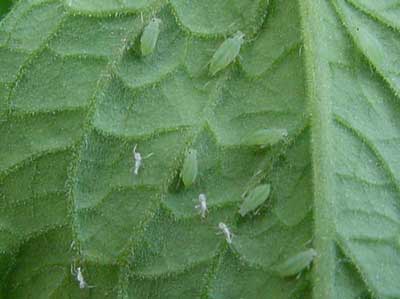
- pepper buds do not open, fade, dry and fall;
- the upper young shoots of pepper deform and dry out;
- pepper stops growing;
- when you touch the sheet with your fingers you feel a sticky surface (due to the aphids);
- the reverse side of the leaf blade glistens when a sun ray hits it (again, due to the sweet aphid aphid).
In peppers that grow on ridges or in a greenhouse and are affected by aphids, you can usually notice a large number of ants. They can move along the stem of the plant, absorbing the honeydew of insects.
Control measures are selected based on the degree of damage to the plants, the number of insects, as well as the conditions in which pepper is grown. In the early stages, when there is still enough time before the formation and ripening of the fruits, you can use "chemistry". For flowering peppers with ripening fruits, it is advisable to use more gentle methods of control, since chemicals are toxic. It is necessary to carefully study the instructions for use of each purchased product, take into account all the recommendations and observe the treatment time and dose.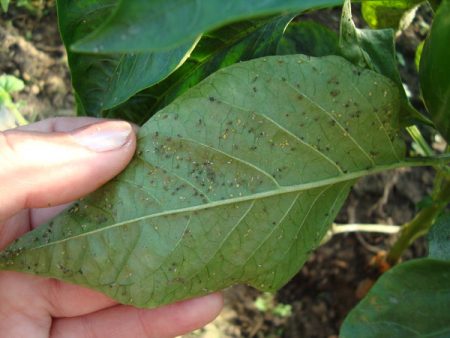
Seed treatment before sowing
Usually, pests primarily attack weakened, unhealthy, stunted plants. Therefore, it is so important to properly prepare pepper seeds before planting, harden and pickle them to get high-quality and full seedlings.
Disinfection contributes to the destruction of possible fungi, spores located on the surface of the seeds, so such procedures should not be neglected.The standard methods for preparing seed material used by almost all gardeners today include:
- sorting;
- dressing;
- hardening;
- germination.
A saline solution is used to select the most viable pepper seeds. In a liter of pure water, salt is dissolved (2-3 tablespoons), mixed thoroughly, and then the seeds are lowered into a jar. Those that come up are not suitable for sowing, but the “heavy” seeds are the ones that will give good seedlings. They are carefully removed, washed, dried.
A simple and time-saving technique is to pickle peppers in potassium permanganate. In a pink solution, the seeds are immersed for no more than 20 minutes, then they are also removed and washed with clean water. If you want, you can additionally stand the peppers in a growth stimulator, which contributes to the friendly germination of seeds.
Hardening is carried out by placing the seeds in the refrigerator for about 1-1.5 days, keeping the temperature at least minus 1 degree. It is important not only to prepare seeds for sowing, but also to pickle the soil where peppers will be grown. To do this, they use the same potassium permanganate, but the solution is made more saturated, dark purple. Pepper seeds are sown in the prepared mixture not earlier than two days later, so that potassium permanganate has time to soak into the soil.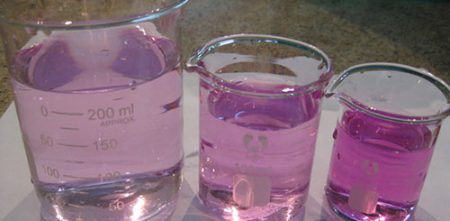
All these measures are preventive, providing protection of peppers from various infections, good germination. But at the same time, do not forget about observing the rules for growing this crop, temperature conditions, proper watering. Often it is a violation or non-observance of the rules (too hot temperature, excessive watering) of agricultural technology leads to the appearance of aphids on peppers.
Pepper processing
As soon as you notice that your peppers are affected by aphids, you must immediately treat the plants. Well, if the amount of the pest is small, then fighting it is easier. If for some reason you missed the initial appearance of aphids or did not attach much importance to it, and whole colonies of insects formed on peppers during this time, you will have to act very decisively and resort to serious means.
All control measures are divided into three groups:
- Application during the treatment of folk remedies.
- Fighting aphids with various chemicals.
- Attraction of volunteers to help, as well as the use of biological agents.
The choice of method depends on the scale of the lesion, the number of pests on the bushes, as well as the number of plantings of peppers.
Folk remedies
Gardeners have in their arsenal many recipes of various compositions for fighting aphids. Folk remedies are popular due to the fact that they allow (especially with a small pest damage) to achieve a good result without the use of toxic chemicals. Each grower seeks to get a high yield, but at the same time environmentally friendly. And folk remedies will be an excellent help in this.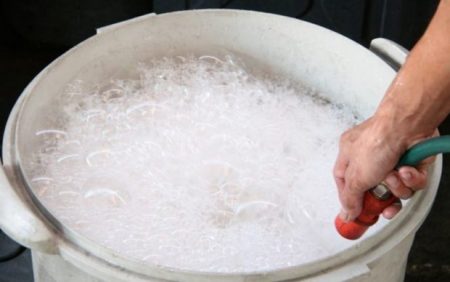
Their effectiveness is better manifested where the number of aphids is small. Also, all these compounds are used as prophylactic agents, as a measure of protection against a dangerous insect. By the way, many of them help not only with the defeat of peppers by aphids, but also prevent the appearance of other pests, as well as various infections.
- The use of soap solution. It is this recipe that most gardeners resort to when aphid is noticed on pepper. The components are simple: planed laundry soap (some use liquid soap), clean hot water. About 10 grams of soap will be needed per liter. The composition must be well mixed, allowed to cool, and only then process the bushes of pepper.
With a soapy solution, you can wipe the leaves of pepper on either side, at the same time and removing aphids from the surface.
- To combat aphids, many use ash, preparing an infusion from it. Sifted ash (three glasses) is bred in warm water (10 liters), insisted for about two days. In order to keep the composition longer on the bushes, it is recommended to add soap to the ash infusion.
- They also make water infusion of tobacco with soap. If there are dried tobacco leaves, then they must be crushed, filled with warm water (take two buckets of water per pound of leaves), can withstand two days. Soap shavings are added, the affected peppers are mixed and sprayed.
- An effective remedy is the infusion of tomato tops. After removing leaves or pinching, the tops are not thrown away, but poured with hot water and insisted. The more leaves, the richer the composition will be, and the more effective the result. Soap is also added to this infusion for better adhesion.
- Each mistress will also find mustard powder, the infusion of which also helps with aphids. First, the powder is diluted and insisted for 2-3 days in a small amount of water (30 grams of dry mustard are taken per 0.5 liter), then 9 liters of water are added (to make an approximately full bucket), stirred and used for spraying.
- Infusions of various odorous herbs are used from aphids: chamomile, celandine, yarrow, dandelion. It is better to fill the formulations with hot water, give time for infusion, and then use it for processing.
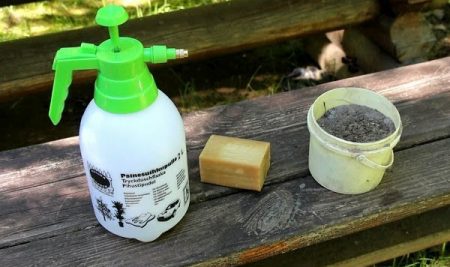
Compositions with ammonia (two tablespoons of the product will need to be taken in a bucket of water), spruce needles (it can be replaced with spruce pharmacy oil), soda (a spoonful of soda is diluted per liter of warm water, some soap shavings are also good results).
These recipes are suitable for use on pepper seedlings, since it is unsafe to spray plants with chemicals at home. Unfortunately, often formulations prepared according to folk recipes are not very effective. Insects have good survival, their reproduction is (especially under favorable conditions) very quickly, but because herbal infusions or tobacco leaves are powerless to cope with the pest. In this case, drugs for gardeners will help, which include potent chemical components.
Chemicals
Chemicals are effective, and even if a large number of aphids are found on peppers, the result will be with these drugs. But we must remember the toxicity of the substances used, compliance with the processing rules, the timing of the procedure.
Each product has a detailed instruction, which indicates the time of the treatments, the multiplicity, the dosage. Hazard class, recommended conditions (prohibition of use near water bodies, other restrictions), phytotoxicity are taken into account.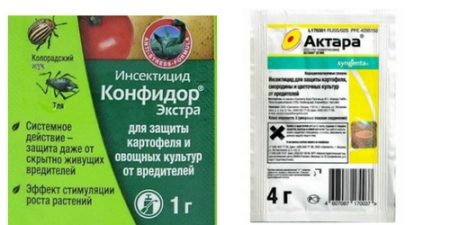
It is advisable to treat plants with solutions with drugs in the evening, on a calm day, taking into account weather conditions (for peppers grown in open ground). If it is forecasted that it will rain, it is better to postpone the treatment, since precipitation rinses off the plants and the treatment results are reduced.
From aphids, drugs are used:
- Spark;
- Confidor;
- Inta Vir;
- Actellik;
- Actara;
- Fury.
As you can see, the list (in addition, it is also incomplete) is quite large, so you can choose the most suitable drugs for specific conditions. So, the drug Fufanon can be used against a number of pests, it is effective for large concentrations of aphids and severe damage to plants. However, it is not as toxic as, for example, Aktara.
Inta-Vir has a contact and intestinal effect. The drug is used, preparing a solution for spraying and diluting tablets in water. Dosage - strictly according to the instructions, while it is recommended to process Inta-Vir peppers before flowering.
Actara’s product is highly effective, but at the same time it has a 3 hazard class, toxic to many insects. Treatment with Actara is done twice to achieve the complete destruction of pests.
In case of long rainy weather, you can use the drug Confidor. This composition is not washed off after treatment with rain, and the result is noticeable after a few hours. Pepper protection is provided for about a month.
For peppers in a greenhouse, it is recommended to use Actellik, which has instant action. The drug is released in ampoules, diluted in water strictly at the specified dose. The hazard class is high, therefore, it is mandatory to use protective equipment when working: gloves, glasses, protective clothing, and a respirator.
Each drug has its own instructions, but the general rule is the use of the drug no less than 20-25 days before collection from the fruit plants.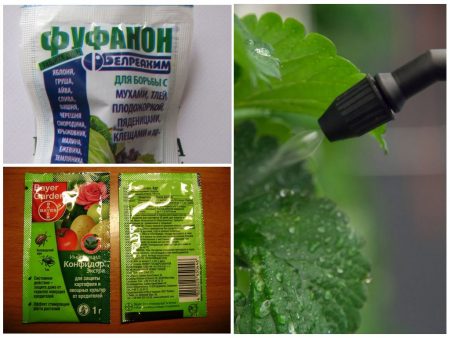
Biathlon
Of particular note is the use in the fight against aphids on peppers of special biological products. They are the means of a new generation, have an effective effect and can be used in any period of vegetation.
Biological products and their features:
- Fitoverm is perhaps one of the most famous drugs in this group. Apply according to the instructions, the basis of the drug is aversectin, thanks to which the drug acts almost instantly. The effect is noticeable after about 3-4 days, the effect lasts up to 20 days.
- Arrow - a drug based on bacterial spores. The active substance - bitoxibacillin, after treatment, the aphid begins to "hurt", ceases to absorb food normally and as a result dies. Complete destruction of the pest - after about 10 days. In addition to aphids, this drug is also dangerous for other insects that damage garden crops; therefore, it can be used in a variety of situations.
- Entobacterin powder contains bacterial spores and special protein crystals that are toxic to insects. The peculiarity of the use of this tool is that its effect is better manifested at high temperatures (+ 25ºC and above), and you can use the composition at any stage of pepper growing.
- Tanrek biological product belongs to contact and intestinal insecticides. It is produced in ampoules and bottles, effective against aphids, as well as a number of other pests. Good results are obtained when processing peppers in greenhouses. The waiting period is about three days, protection is provided for up to a month. This drug is not phytotoxic, its effectiveness does not depend on temperature, and to achieve a better result, you can combine it with Fitosporin.
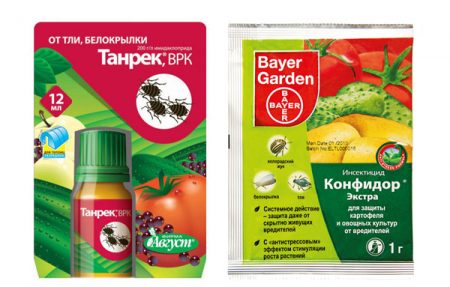
Also, to combat aphids attract feathered helpers - bluebirds, sparrows, hemp, which willingly eat insects. On the site there should be feeders, birdhouses, and in a cold tear berry, it is advisable not to forget to feed the birds. In the summer they will thank you, destroying not only aphids, but also other pests dangerous to the garden and the garden.
The well-known ladybugs, ground beetles, beetles help to fight aphids. If there are a lot of these natural helpers on the site, then no aphids of your landings will be scary. To attract beneficial insects, it is recommended to grow various aromatic herbs, which, by the way, do not like aphids. These are marigolds, garlic, basil, lavender, which can be planted near the beds with peppers or tomatoes.
It must be remembered that the use of pesticides leads to the death of not only harmful, but also beneficial insects. Therefore, it is always necessary to consider what result will be obtained when applying "chemistry".
Preventive measures to combat dangerous aphids include maintaining crop rotation and maintaining cleanliness on the site (timely cleaning of all plant debris, removing affected plants and disposing of them), and disinfecting the soil and enriching the soil with green manure crops. It is very important to weed, to prevent excess soil moisture, since in many cases this is the reason for the appearance and rapid reproduction of aphids. You should also destroy the ants, which contribute to the increase in the number of aphids.
Aphid not only harms the crop, it is a peddler of various diseases. Having settled on peppers, the pest attacks other crops, which leads to infections. So do not underestimate the enemy and, when he appears, promptly take all measures to protect plants.
Reviews
Helena
I had aphid on my pepper Belozerka. I saw late, treated with soapy water, but did not help. Fitoverm was advised, this is a very good tool. The aphid has disappeared. And a neighbor told me that she bury onion husks in the soil in the spring and the aphid does not appear. I’ll also try, perhaps, it’s better than poisoning the plant with pesticides.
Rose, Moscow Region
Soap is probably good, but I did not see any effect from it. Perhaps modern pests are already accustomed to such poison for them, and have adapted. In the store, the saleswoman showed me a whole bunch of all kinds of funds, I chose Fury, used according to the instructions. I had aphids on peppers and shrubs. All brought. I was afraid that again in the new season these parasites are torturing, but, surprisingly, there were no aphids. Although now I know how this muck can be deduced immediately.
Nikolay
I had a sea of aphids, peppers grew in a greenhouse. Last year, they sprayed tobacco, all the aphids fell. As they saw this summer, they immediately brought the tobacco infusion, processed it. The result is zero, and insects, as if even more. At the indoor city market in the garden department, Aktar was advised in powder. Spread out in water, sprinkled peppers and captured eggplants, they also noticed aphids on a pair of bushes. After treatment, the aphid immediately crumbled from the bushes, and everything disappeared. This, I understand, is the effect.




 Calorie pepper stuffed with meat and rice - BZHU per 100 grams
Calorie pepper stuffed with meat and rice - BZHU per 100 grams Gorky pepper - the best varieties for open ground
Gorky pepper - the best varieties for open ground Hot pepper seeds - the best varieties for open ground and reviews
Hot pepper seeds - the best varieties for open ground and reviews Capsicum tincture for hair - how to use and reviews
Capsicum tincture for hair - how to use and reviews